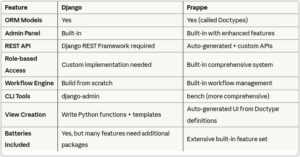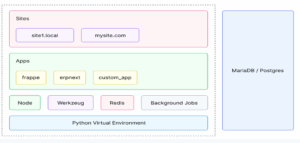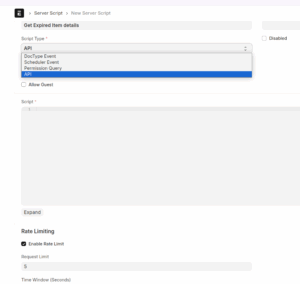Frappe Framework Python vs Django: Complete Guide to Features, Architecture and Use Cases
Frappe Framework Python vs Django: Complete Guide to Features, Architecture and Use Cases
Frappe Framework Python vs Django: Why It Cuts Development Time by 70% vs Django
Frappe Framework Python vs Django is a critical comparison for Python developers building business applications. While Django remains popular, Frappe Framework Python dramatically reduces development time—by up to 70%—for internal business tools and SaaS platforms thanks to its metadata-driven, low-code architecture.
What is Frappe Framework Python?
Frappe framework Python is a full-stack web application framework built on Python and JavaScript. It is designed to make web application development faster by providing a low-code, metadata-driven approach. Frappe framework Python powers ERPNext, an open-source ERP system and multiple other opensource apps, and is known for its tightly integrated ecosystem, automatic API generation, and modular architecture.
Key Features of Frappe Framework Python:
- Doctype-based ORM: Provides a structured way to define database models, replacing traditional Django models
- Built-in Admin UI: Every Doctype automatically generates UI components
- Multi-tenancy: Supports multiple sites with a single codebase
- Event-driven Architecture: Uses hooks to extend functionalities without modifying core code
- Background Jobs and Queue System: Easily manage long-running tasks and monitor from desk
- Auto-generated REST APIs: Every Doctype gets an API without additional coding
- Role-based access control by default
- Workflow engine for business processes
- Reporting tools and dashboard capabilities
Why Choose Frappe Framework Python?
Frappe framework Python is an excellent choice for developers looking to build business applications quickly with minimal effort. Unlike Django, which requires manual API creation, admin panel setup, and frontend integration, Frappe framework Python provides these features out-of-the-box.
Frappe Framework Python vs Django: Key Differences

Frappe Framework Python vs Django
Deep Dive into Frappe Framework Python Features
DocTypes in Frappe Framework Python (Replacing Django Models)
In Django, models define the structure of database tables, and migrations manage schema changes. In Frappe framework Python, DocTypes serve the same purpose but offer additional UI and APIs.
Example: Creating a DocType in Frappe Framework Python
|
1 2 3 4 |
bench new-app my_app bench --site mysite.localhost install-app my_app bench --site mysite.localhost console |
Create a DocType via UI or by defining a JSON file:
|
1 2 3 4 5 6 7 8 |
{ "doctype": "Employee", "fields": [ {"fieldname": "first_name", "fieldtype": "Data"}, {"fieldname": "last_name", "fieldtype": "Data"} ] } |
Migrations in Frappe Framework Python vs Django
- Django: Uses
makemigrationsandmigrateto manage schema changes - Frappe framework Python: Stores DocType definitions as JSON files, automatically applying changes or using
bench migratecommand
To apply changes in Frappe framework Python:
|
1 2 |
bench --site mysite.localhost migrate |
Architecture

Frappe framework architecture
MVC in Frappe framework Python vs Django: Frappe framework Python follows an extended MVC model where DocTypes act as both models and controllers.
- Multitenancy: Frappe framework Python supports multiple sites natively
- Views, Sites, and Apps: Frappe framework Python apps encapsulate functionalities, and multiple sites can run on a single instance
Building APIs and CRUD Operations
Frappe framework Python provides APIs automatically:
GET /api/resource/EmployeePOST /api/resource/Employee
Django requires DRF and manual setup.
ORM Operations in Frappe Framework Python vs Django
Frappe framework Python ORM Examples:
|
1 2 3 4 5 6 7 8 9 10 11 12 13 14 |
# Fetch all employees employees = frappe.get_all("Employee", fields=["first_name", "last_name"]) # Fetch a single employee record employee = frappe.get_doc("Employee", "EMP-0001") # Create a new record new_employee = frappe.get_doc({ "doctype": "Employee", "first_name": "John", "last_name": "Doe" }) new_employee.insert() |
Background Jobs in Frappe Framework Python
Frappe framework Python supports scheduled tasks via cron-like scheduling in hooks.py:
|
1 2 3 4 |
scheduler_events = { "daily": ["my_app.tasks.daily_task"], } |
Example scheduled task:
|
1 2 3 4 5 |
import frappe def daily_task(): frappe.db.set_value("Employee", "EMP-0001", "status", "Active") |
Queue System in Frappe Framework Python
|
1 2 |
frappe.enqueue("my_app.tasks.send_email", recipient="user@example.com") |
Caching in Frappe Framework Python
Uses Redis for caching:
|
1 2 |
frappe.cache().set("key", "value") |
Hooks Mechanism for Customization
Example hooks in Frappe framework Python:
|
1 2 3 4 5 6 7 8 9 10 |
override_whitelisted_methods = { "frappe.desk.doctype.event.event.get_events": "my_app.api.get_events" } doc_events = { "Employee": { "on_update": "my_app.api.on_employee_update" } } |
User Management and Authentication
Frappe framework Python includes role-based authentication:
|
1 2 3 |
user = frappe.get_doc("User", "user@example.com") print(user.roles) |
Users can be assigned permissions via Role-Based Access Control (RBAC) in Frappe framework Python.
Server Scripts directly from UI

Frappe server-side automation
Execute APIs, Permission Queries, Doc Events, and Cron Jobs directly from the UI without any deployment in Frappe framework Python.
Why Choose Frappe Framework Python?
1. Faster Development Cycle
The auto-generation of UI and APIs in Frappe framework Python means you spend less time on boilerplate and more time on business logic.
2. Low-Code Approach
Define your data structure once in Frappe framework Python, and it handles the rest—forms, APIs, permissions, and even basic workflows.
3. Enterprise-Ready Features
Built-in features like user management, reporting, audit trails, and workflow automation that would take weeks to implement in other frameworks are ready in Frappe framework Python.
4. Open Source & Extendable
You’re not locked into a proprietary system. You can customize and extend Frappe framework Python as needed, with full access to the Frappe GitHub repository.
Where Frappe Framework Python Saves Significant Time
Based on experience, Frappe framework Python excels in these scenarios:
Internal Business Applications
- HRMS systems: Employee management, leave tracking, performance reviews
- CRM platforms: Lead management, customer interactions, sales pipelines
- ERP solutions: Inventory management, accounting, procurement
SaaS Applications
- Multi-tenancy is built-in—each site can have its own database and customizations
- User management and subscription handling are handled out of the box
Rapid MVP Development
- Get a working prototype with real functionality in hours, not days
- Perfect for validating business ideas quickly
Workflow Automation Tools
- Built-in workflow engine for approval processes
- Background job processing and schedulers
- Notification systems for user engagement
When to Stick with Django
Frappe framework Python isn’t a silver bullet. Here are scenarios where Django might be better:
Highly Custom Web Applications
If your application has unique architectural requirements or needs extensive customization of the request-response cycle, Django’s flexibility might be better.
Performance-Critical Applications
For applications where you need fine-grained control over performance optimization, Django’s minimalist approach might be preferable.
AI/ML Applications
Django’s extensive ecosystem and integration with data science libraries make it a better choice for AI/ML-heavy applications.
Microservices Architecture
If you’re building a distributed system with microservices, Django’s lightweight nature might be more suitable.
Real-World Impact
In team evaluations, Frappe framework Python can reduce development time by 60-70% for internal business applications. Tasks that would typically take weeks in Django—like building admin interfaces, setting up user roles, creating reports—are accomplished in hours with Frappe framework Python.
However, this comes with a trade-off: you’re working within Frappe framework Python’s conventions. If your application fits well within these conventions, you’ll see massive productivity gains. If not, you might find yourself fighting the framework.
Getting Started with Frappe Framework Python
To start with Frappe framework Python, visit the official Frappe website and follow the installation guide using Frappe Bench.
Conclusion
Frappe framework Python represents a different philosophy in web development—prioritizing rapid development and built-in functionality over architectural flexibility. For internal business applications, SaaS platforms, and rapid prototyping, it can be a game-changer.
As Python developers, we often get caught up in building everything from scratch. Sometimes, using a framework like Frappe framework Python that handles the common patterns allows us to focus on what really matters: solving business problems.
The key is choosing the right tool for the job. Frappe framework Python won’t replace Django in every scenario, but for the right use cases, it can dramatically accelerate your development process.
Resources
- What is Frappe Framework?
- Understanding the MVC Architecture in Frappe
- Learn more about Building REST APIs in Frappe
Suggested Reads
Have you tried Frappe framework Python in your projects? I’d love to hear about your experiences in the comments below. If you’re considering it for your next project, feel free to reach out with questions—I’m happy to share more insights from our team’s evaluation.
Related content
Auriga: Leveling Up for Enterprise Growth!
Auriga’s journey began in 2010 crafting products for India’s
